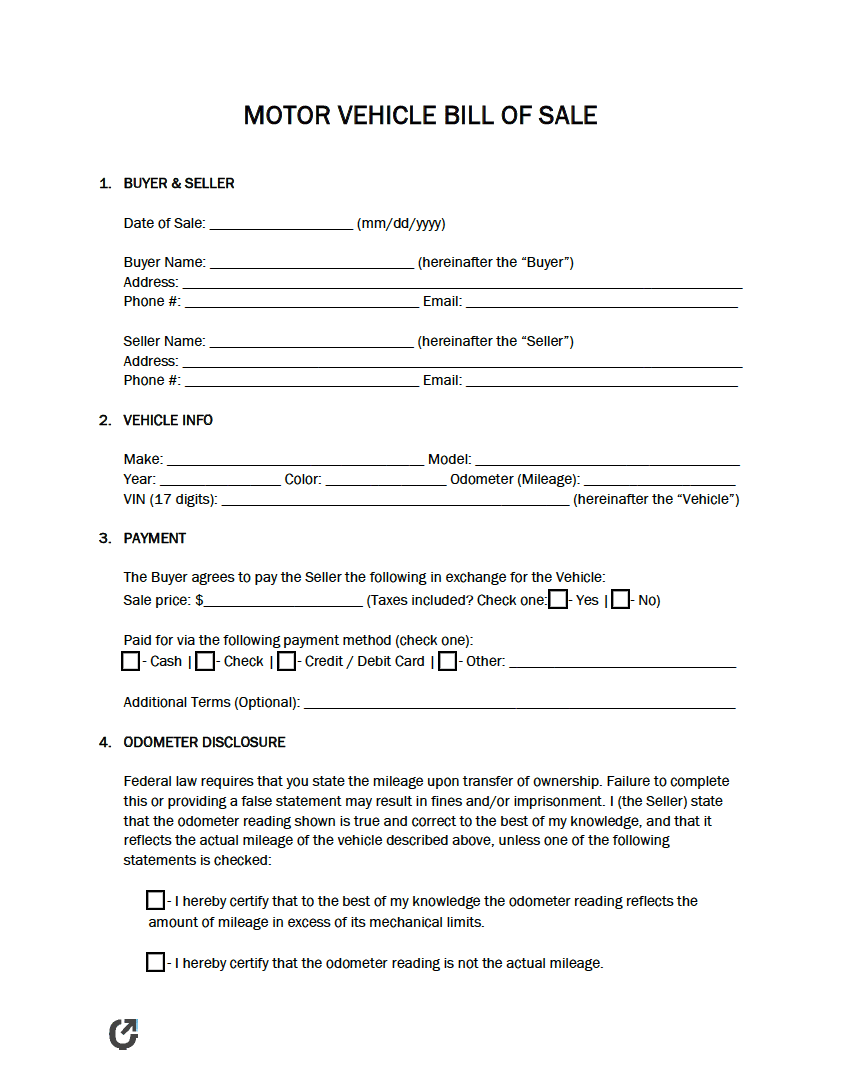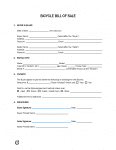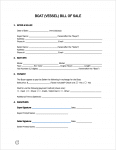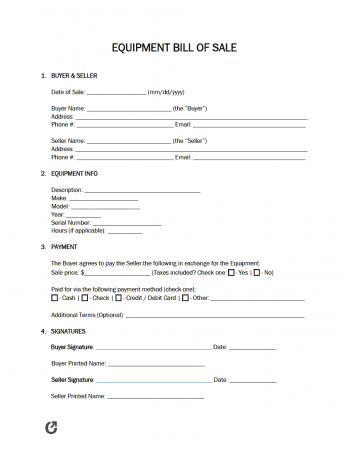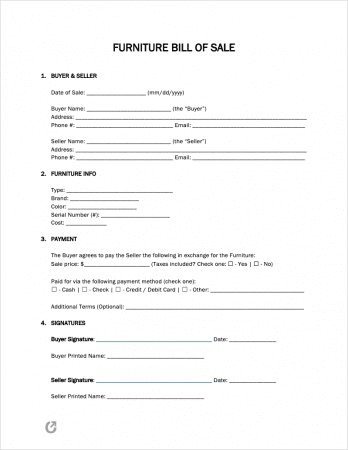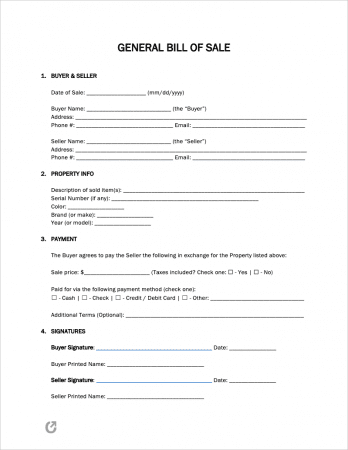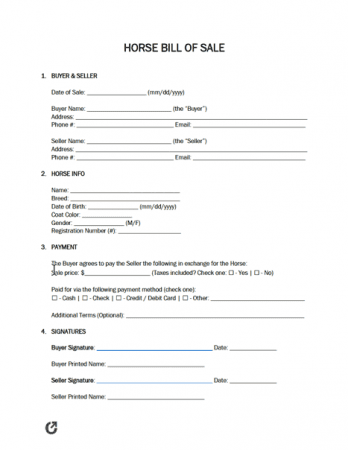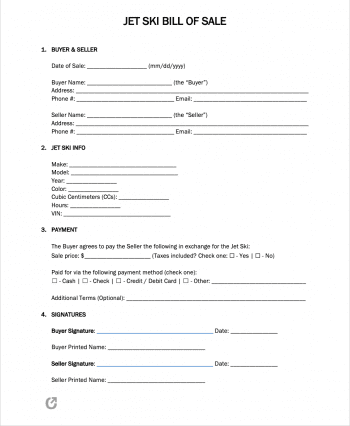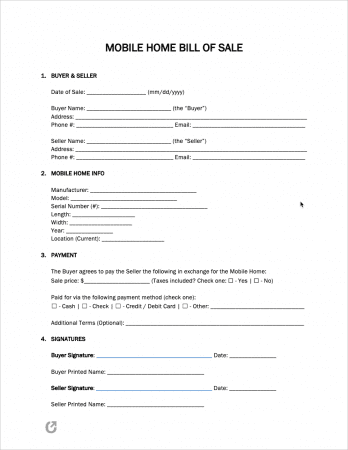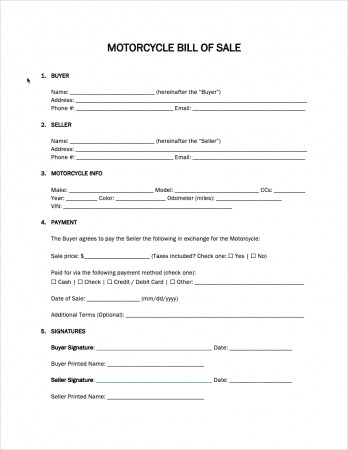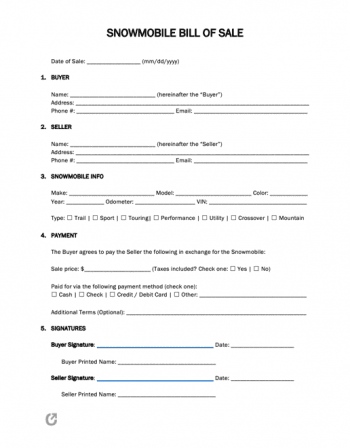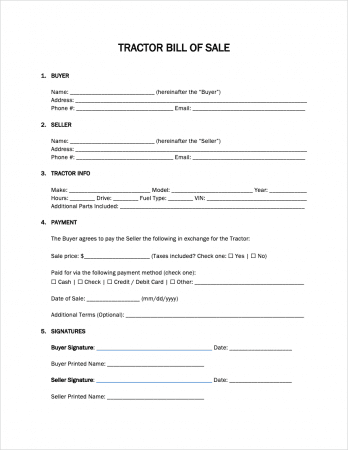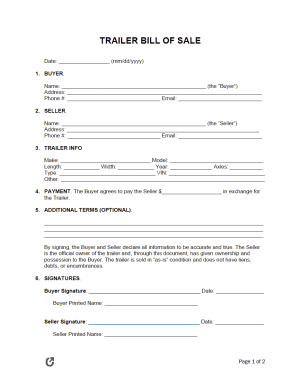Simple Bill of Sale Forms (20 Types)
A bill of sale is a document used to record the sale of property from one person to another. Like a receipt, the contract records the amount the item sold for, the contact information of the person that bought and sold it, and the date the sale occurred. Bill of sale forms are most commonly used when selling a motor vehicle, although they can be used for recording the sale of nearly any type of personal property.
Summary
|
Bill of Sale: By State
- Alabama
- Alaska
- Arizona
- Arkansas
- California
- Colorado
- Connecticut
- Delaware
- Florida
- Georgia
- Hawaii
- Idaho
- Illinois
- Indiana
- Iowa
- Kansas
- Kentucky
- Louisiana
- Maine
- Maryland
- Massachusetts
- Michigan
- Minnesota
- Mississippi
- Missouri
- Montana
- Nebraska
- Nevada
- New Hampshire
- New Jersey
- New Mexico
- New York
- North Carolina
- North Dakota
- Ohio
- Oklahoma
- Oregon
- Pennsylvania
- Rhode Island
- South Carolina
- South Dakota
- Tennessee
- Texas
- Utah
- Vermont
- Virginia
- Washington
- Washington D.C.
- West Virginia
- Wisconsin
- Wyoming
By Type (20) |
What is a Bill of Sale?
A bill of sale is a form used to prove that a buyer received an object through cash, trade, or gift from a seller. It does not need to be complex, nor does it need to contain long-winded clauses. When completing a bill of sale, both parties must ensure they answer the following questions:
- Who is selling, and who is buying?
- How can I reach the buyer/seller?
- What is the owner selling?
- What is the item’s value?
- How much money is the merchant selling the object for?
- When is it being sold?
How to Sell a Car (6 Steps)
Use the following six (6) steps as guidance when selling a car.
Step 1 – Clean it

The owner should prepare the car by giving it a thorough interior and exterior clean. Taking this step increases its value and makes it more appealing to buyers. If the seller does not have time to wash it themselves, they can take it to a professional detailer.
Step 2 – Gather Documents

After washing the vehicle, collect the necessary paperwork. Create an organized binder containing the bill of sale, title, vehicle history reports, license plate(s), maintenance records, warranty documents, and other relevant forms.
Titling requirements vary by state. Residents living in title-holding states (Kentucky, Maryland, Michigan, Minnesota, Missouri, Montana, New York, Oklahoma, and Wisconsin) have possession of the document, even if they have not paid off the loan for the car. In the other forty-one (41) states, the lienholder has possession of the title until the owner pays the loan.
The owner can still sell the car even if they have not paid their lienholder. In this scenario, the buyer pays the seller for the vehicle, and, in turn, the seller reimburses the lienholder. The lienholder then releases the title to the seller, who signs it over to the buyer. To ensure that the process goes smoothly, owners should discuss this matter with the lienholder before selling.
Step 3 – Evaluation

The price on the listing impacts whether or not the car sells. Buyers often estimate the cost before making an offer or touring it, meaning the seller must thoroughly research the value to ensure fair pricing.
Generally, new cars, trucks, and vans depreciate by 20-30% after one (1) year of ownership. For the next two (2) to six (6) years, the value goes down by 15-18%. However, this price assessment can change according to the demand of the vehicle, its make, model, year, condition, and color.
To receive an accurate appraisal, visit a local dealer or use an online service. Kelly Blue Book and NADA provide individuals with a realistic valuation. If the car has a significant issue or a low value, the owner can decide to sell it solely for parts. Junkyards usually accept broken down or low-priced vehicles for $500 to $900; however, this amount varies according to the quality or demand of the parts.
Step 4 – List it

Upon determining the price, the seller’s next step is to advertise the car. Marketing can happen in three ways: 1) online, 2) through a dealership, or 3) fliers and physical postings.
Individuals often use online services to advertise a car. This method allows them to post a description of the vehicle, photographs, and other essential details. It also lets the buyer communicate with the seller to determine prices or set up tours.
Owners can have a dealer take care of the selling process if they cannot. This method is more efficient but less profitable since the dealership takes a portion of the earnings.
Fliers and other paper listings provide buyers with a tangible document to inform them of the sale. The owner usually lists their name, phone number, email, or address so that others can get in contact with them.
Step 5 – Negotiate + Sign Bill of Sale

Shortly after listing the vehicle, potential buyers will contact the seller to ask questions and set up tours. They might try to bargain or negotiate to lower the price, and therefore, the seller should prepare by having a firm set price in their mind. This way, they will feel less persuaded by the potential buyer and make a fair trade.
Once both parties have determined a price and agreed on the terms, they must complete a motor vehicle bill of sale form. They must include information about the car and the payment details. Each person then signs to verify the sale. The buyer and seller must sign in front of a notary public if they reside in a notarization-required state.
Step 6 – Make the Exchange

Only after both parties sign and the buyer pays the seller should the seller hand over the keys. This process ensures that the buyer does not scam the seller or visa-versa. Since the bill of sale binds each person to the agreement, it becomes less risky to engage in the deal once they sign the form.
Note that the buyer must pay in full, as a bill of sale is not a payment plan. In other words, the buyer cannot pay the seller in disbursements. Instead, they must pay the total amount at the sale. The seller must also give the buyer any agreed-upon extras (e.g., car parts, documentation, utility trailers, etc.) when giving them the vehicle.
Frequently Asked Questions (FAQ)
Reference the queries below to learn more about bill of sale forms.
Is a Bill of Sale Legally Binding?
It depends. On its own, the bill of sale generally does not act as a legal contract. Overall, the amount of information included in the document determines whether or not the court can uphold it.
Signed and notarized forms often give it more leverage in the eyes of the law. Attaching other paperwork (such as purchase agreements, operating agreements, and promissory notes) gives the bill of sale further credibility.
What is a Notarized Bill of Sale?
A notarized bill of sale includes a signature, seal, or stamp from a notary public. A notary public is a certified individual sworn by law to witness the signing of a document. Notarization boosts the integrity of a bill of sale form as it tells third parties that the deal lawfully happened.
How Do I Notarize a Bill of Sale?
Complete all information in the form except for both parties’ signatures and the date. Find a local notary public and make an appointment. Attend the meeting with the bill of sale in hand and a form of photo identification (ID). The notary public will use the ID to verify each person’s identity and private information listed. Then, they will witness the buyer and seller sign and date the document before signing themselves and entering any other applicable details.
Can You Get a Title with a Bill of Sale?
In many states, you can use a bill of sale to prove ownership to obtain a title or registration. Generally, only boats and cars have this requirement, if at all. Residents should reference local laws to see if they need a bill of sale. If they need one, the individual must include the information required by their county or state. For example, it may require notarization or accompanying documents.
Does a Bill of Sale Prove Ownership?
Yes, a bill of sale proves ownership as long as the relevant parties have signed or notarized the document. Essentially, it confirms that a transaction happened after the willing parties made a deal.
Does a Bill of Sale Release Liability?
Yes, a bill of sale releases liability if both parties sign it. The previous owner no longer has responsibility, and as a result, the new owner attains rights and accountability for it.
Do I Need a Bill of Sale?
Each state (and sometimes each county) has separate bill of sale laws, meaning that you do not necessarily need it unless you live in an area that mandates it. These states often require individuals to present the signed bill of sale when registering a car, boat, or gun.
What Does “In Consideration Of” Mean on a Bill of Sale?
“In consideration of” means the amount of money that a buyer spends on a bill of sale item. This part of the form must include the exact payment details of the transaction, such as the sale price, payment type, and tax information. If the deal occurs by trade or gift, the seller still needs to enter the item’s current value.
Can You Sign a Bill of Sale for Someone Else?
Yes, you can sign a bill of sale for someone as long as the owner has completed a motor vehicle power of attorney form. The document must explicitly state that the named person can buy or purchase the vehicle and inscribe on their behalf.
How to Get a Bill of Sale From a Dealership
When buying new or used property from a dealership, the dealer provides the customer with the proper documentation, including a bill of sale form. They must discuss the contents of the paperwork with the individual and work together with them to complete it. If the document requires notarization, both parties must sign in the presence of a notary public.
Should You Sign a Bill of Sale Before Payment?
Yes, you should sign a bill of sale form before payment. This step protects both parties from theft and scams. The signed bill of sale serves as evidence of an agreement made between two (2) willing individuals. It states that a buyer will compensate a seller in exchange for ownership of an item. If a person does not uphold their side of the deal, the other can file a legal claim, using the document as evidence of the agreed-upon arrangement.
How to Write a Bill of Sale for a Car (6 Steps)
Reference the steps below to complete a car bill of sale with the buyer.
Step 1 – Buyer & Seller
Enter the date of the sale. Next, disclose the buyer and seller’s name, address, phone number, and email.

Step 2 – Vehicle Information
State the following identifying details of the car: the make, model, year, color, odometer (mileage), and vehicle identification number (VIN).

Step 3 – Payment
Include the sale price for transactions occurring by currency, check, card, or other cash-based methods. Check “Yes” or “No” depending on whether the buyer paid taxes during the sale. Then, check the box associated with the payment type.
If the deal happened by cash or trade, provide the details under the “Additional Terms” section. The seller must give a fair valuation of the car in this section.

Step 4 – Odometer Disclosure
Refer to the mileage stated in section two (2): vehicle info. Do not check the boxes listed under section four (4) if the number is accurate. Select the first box if the reading is more than its mechanical limits. Choose the second box if the odometer reading is not true and correct.

Step 5 – Signatures
Each party must inscribe their full name, signature, and the date of the signing.

Step 6 – Notarization (Optional)
Notarization is only mandatory in states that require it. The notary public must complete the fillable fields in the “Certificate of Acknowledgement” section.

